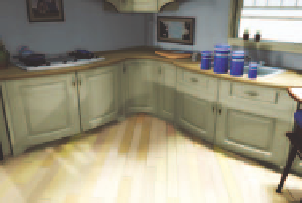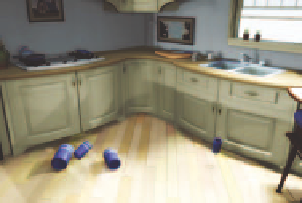Graphics Reference
In-Depth Information
That's all you need to do. There are several ways to capture the resulting physics simulation, but the simplest is
to put the mouse over the 3D view and press the
Ctrl-Alt-Shift-P
key combination. Blender will think for
a moment (or longer, if things are really complex), then return control to you. During that time, it will have
calculated the physics simulation for the frame range specifi ed in the animation buttons and created motion
Ipos for any objects that were fl agged as
Dynamic
in the
Logic
buttons. The resulting animation can be
played, as any other animation, with
Alt-A
.
If the simulation isn't to your liking, simply reposition the items or rekey the driving object and press
Ctrl-
Alt-Shift-P
again. A new solution is calculated and stored in the objects' Ipos. You can also play around
with individual object settings like
Mass
and
Damping
, which will affect the way that the objects interact
with each other. The physics engine understands things such as momentum and density, so lighter, smaller
objects slamming into larger, heavier ones will generate the appropriate response and
vice versa
.
When you are happy with the simulation, there are a couple of different ways to integrate it back into your
main shot. Perhaps the easiest way is to have created the simulation directly within the shot fi le that requires
it, but contained on a normally unused and hidden layer. In this way, the real high resolution objects can be
made children of the corresponding objects in the simulation. As long as the starting positions of the low-
resolution stand-ins and the high-resolution geometry are close enough, this is all you have to do. With the
simulation layer hidden, the high resolution geometry will move along with the lower resolution simulation
objects, giving you believable physics with very little effort.
Several frames of a completed simulation are shown in Figure 14.36.
Figure 14.36
The canisters go fl ying
The simulation may end up with items falling a bit into the ground, or, in this case the fl oor, but that is easily
fi xed. As the simulation has been recorded into Ipos, all of the Ipo editing skills you have acquired in Blender
apply. For example, if the simulation causes one of the canisters to end up passing through the fl oor a bit, a





Search WWH ::

Custom Search